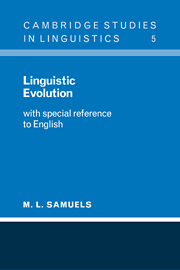Book contents
- Frontmatter
- Contents
- Preface
- Note to second impression
- Abbreviations
- 1 Introduction
- 2 Variation in the spoken chain
- 3 System: the phoneme
- 4 Grammar and lexis (I): variation
- 5 Grammar and lexis (II): systemic regulation
- 6 Diversity and contact
- 7 An assessment of the problem
- 8 Dimensions of study
- 9 Conclusions
- Bibliography
- Index of persons
- Index of subjects
- Plate section
6 - Diversity and contact
Published online by Cambridge University Press: 05 June 2012
- Frontmatter
- Contents
- Preface
- Note to second impression
- Abbreviations
- 1 Introduction
- 2 Variation in the spoken chain
- 3 System: the phoneme
- 4 Grammar and lexis (I): variation
- 5 Grammar and lexis (II): systemic regulation
- 6 Diversity and contact
- 7 An assessment of the problem
- 8 Dimensions of study
- 9 Conclusions
- Bibliography
- Index of persons
- Index of subjects
- Plate section
Summary
Introductory
The purpose of chapters 2–5 has been to examine the types of possible intrasystemic change; and if such change is regarded as a whole, without specifying any given type or direction for it, then some degree of it can be regarded as predictable for all systems in normal use. But some obvious further questions have been deferred until now, namely, why is there more of such change in some systems than in others, and why sooner in some than in others? To answer these, other perspectives must be used: the extralinguistic and extrasystemic factors – hitherto treated only incidentally from the viewpoint of a single system – must now be discussed in more detail.
As was pointed out in 1.4 (p. 7) the exact delineation of the spheres of these two terms can at times be difficult, but there are certain unambiguous uses of ‘extralinguistic’ that can be disposed of at the outset. Cultures and communities differ; their needs, their customs and their ways of looking at things differ. This point should not be pressed too far, since there is more to unite the total human experience than to divide it; but it is sufficient to account for many superficial differences, not only in the names for the actual objects or concepts in use, but also in the type of distinction chosen for marking.
- Type
- Chapter
- Information
- Linguistic EvolutionWith Special Reference to English, pp. 88 - 134Publisher: Cambridge University PressPrint publication year: 1972



